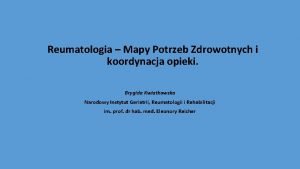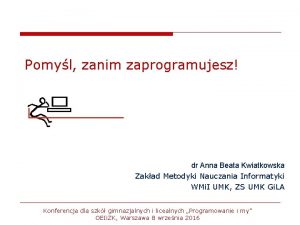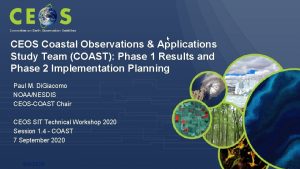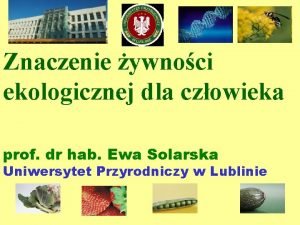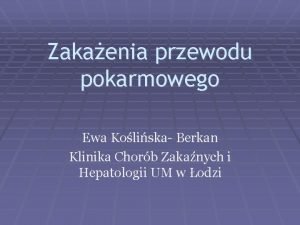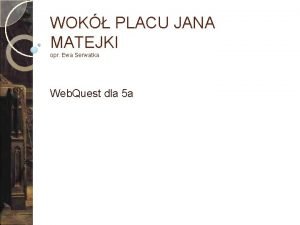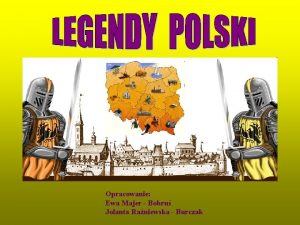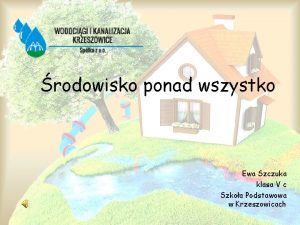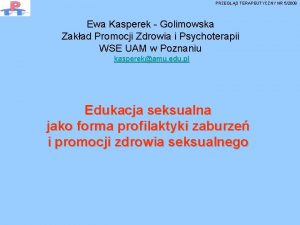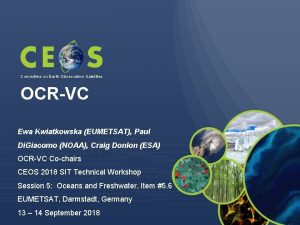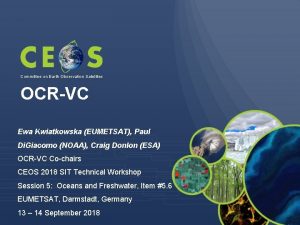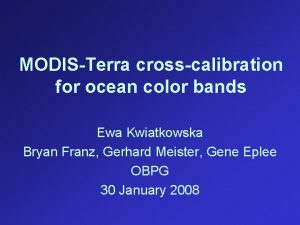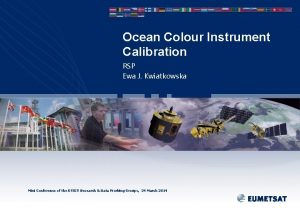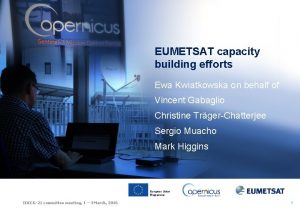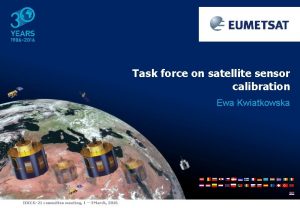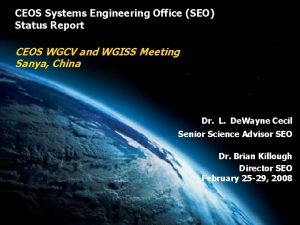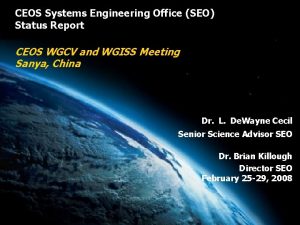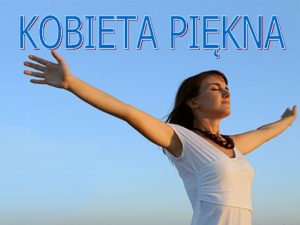Status of CEOS OCRVC and OCRIT Ewa Kwiatkowska











- Slides: 11

Status of CEOS OCR-VC and OCR-IT Ewa Kwiatkowska 1 EUM/RSP/DOC/19/1066605, v 1 Draft, 14 March 2019

2 EUM/RSP/DOC/19/1066605, v 1 Draft, 14 March 2019

INSITU-OCR Document (Requirements) Recommendations Space Sensor Radiometric Calibration, Characterization and Temporal Stability R 1. 1 Comprehensive pre-launch instrument calibration/characterization R 1. 2 Open access to calibration and characterization data In Situ Data / R 3. 1 Improving traceability of in situ measurements Reference Measurements R 3. 2 Continuous consolidation and update of measurement protocols R 1. 3 Permanent working group on satellite Fiducial sensor calibration R 1. 4 Vicarious calibration R 1. 5 Support for calibration teams R 3. 5 Archival of in situ data R 2. 1 Distribution of calibrated and uncalibrated data R 3. 6 Community processor for in situ data R 2. 2 Permanent working groups on algorithm topics R 2. 3 Product uncertainties Information Management and Support R 4. 1 Accessibility and distribution of large volumes of data R 2. 6 Long-term field measurement programs R 4. 2 Processing capabilities for calibration and validation activities R 2. 7 Validation protocols R 4. 3 Accessibility to documentation R 2. 8 Level-3 data products generation R 4. 4 Data formats R 2. 9 Ancillary data 3 R 3. 7 Priority for variables to be collected R 3. 8 General coordination of field campaigns R 2. 4 Regional bio-optical algorithms R 2. 5 Open access to source codes for processing algorithms R 3. 3 Uncertainty budgets R 3. 4 Quality Assurance of in situ data R 1. 6 Assess and correct for instrument degradation Development and Assessment of Satellite Products Recommendations EUM/RSP/DOC/19/1066605, v 1 Draft, 14 March 2019 R 4. 5 Support for open source data processing and visualization

OCR-IT is distributed – following a modular approach coordinated across the agencies VC-09 • Implementation of INSITU-OCR White Paper is advancing 4 EUM/RSP/DOC/19/1066605, v 1 Draft, 14 March 2019

R 1. 4 Ocean Colour System Vicarious Calibration • NOAA – MOBY ongoing operations and technology refreshment • NASA – the first phase of PACE SVC development has been completed, 3 projects funded (3 -year/US$8 M investment) • NASA – the second phase PACE SVC call is open with the goal for the infrastructure to be in water about 2021 • ESA – FRM 4 SOC SVC workshop in Feb 2017 produced Copernicus OC-SVC recommendations, FRM 4 SOC final workshop in Oct 2018 • ESA / CNES / Copernicus – BOUSSOLE ongoing operations • JRC – peer-review publications, OC-SVC requirements • EUMETSAT – the first step “Requirements for Copernicus OC-SVC Infrastructure” available • EUMETSAT – the second step two studies ongoing to provide “Preliminary design of Copernicus OC-SVC Infrastructure” 5 EUM/RSP/DOC/19/1066605, v 1 Draft, 14 March 2019

R 3. 2 Continuous consolidation and update of measurement protocols • IOCCG Ocean Optics & Biogeochemistry Protocols for Satellite Ocean Colour Sensor Validation Volume 1. 0: Inherent Optical Property Measurements and Protocols: Absorption Coefficient (November 2018) • IOCCG draft protocols for public comment available o Best Practices for the Collection and Processing of Ship-Based Underway Flow. Through Optical Data o Protocols for Satellite Ocean Color Data Validation: In situ Optical Radiometry o Inherent Optical Properties Measurements and Protocols: Beam Transmission and Attenuation Coefficients • ESA – FRM 4 SOC radiometry protocols documented, final workshop 4 -5 October 2018 6 EUM/RSP/DOC/19/1066605, v 1 Draft, 14 March 2019

Other selected recommendations • R 1. 3 Permanent working group on satellite sensor calibration • IOCCG / OCR-VC instrument calibration task force - regular meetings at IOCS • R 2. 2 Permanent working groups on algorithm topics • current IOCCG Working Group: Harmful Algal Blooms • current IOCCG Working Group: Intercomparison of Atmospheric Correction Algorithms over Optically-Complex Waters • R 2. 3 Product uncertainties • current IOCCG Working Group: Uncertainties in Ocean Colour Remote Sensing 7 EUM/RSP/DOC/19/1066605, v 1 Draft, 14 March 2019

CEOS COVERAGE initiative • Recommendation was provided for COVERAGE to include variables beyond chlorophyll and to increase spatial resolution <0. 250 • In the meantime, recommendation was also given for COVERAGE to progress with chlorophyll Level-4 development and to liaise back with IOCCG as soon as there are initial results for verification, validation and general review (validation ideas also provided) The recommendation will be for the COVERAGE team to progress with chlorophyll algorithm development following the described methodology and to liaise back with IOCCG as soon as there are initial results for verification, validation and general review. … the interpolation scheme suggested looks promising. As any existing scheme, it invents data where there is none based on assumptions (explicit or implicit) regarding the scales of variability (or spatial decorrelation scales) and statistics of the underlying data (e. g. normality or log-normality within the scale of interest). It will need to be validated. One way to test, one could use low resolution MODIS like satellite as input and see how well the product fairs relative to high resolution products from Sentinel 3, 2 and Landsat 8. I suggest that people independent from the group implementing the scheme do the testing, to insure that no implicit bias play a role. It would be nice to see the technique implemented by COVERAGE with results reviewed thoroughly before putting in mass production. In the past I have seen excellent SST results from optimal interpolation techniques but the same techniques didn’t result in robust outcome for Chl because the latter changes faster than SST in both space and time, and because the latter has way lower valid data points to work on. In any case I think it’s wise to see the Chl outcome first. Meanwhile it would be nice to see the cross-sensor consistency evaluation among the various sensors before different sensors are put in the algorithm. Some similar works were performed few years ago by different teams, using Self-Organizing Maps (SOM) classification methods which makes use of complementary oceanic remote sensing observations (SST, SSH) to fill large data gaps in satellite chlorophyll (CHL) images (not the same objective, but not so far). What they did to validate their approach was based on artificial degradation of clear images to find how the approach is able to recover the reality. 8 EUM/RSP/DOC/19/1066605, v 1 Draft, 14 March 2019

CEOS Work Plan and Carbon • Recommendation to CEOS was provided for stronger emphasis on aquatic biology, biogeochemistry, ecology and harmonization with “CEOS Strategy for Carbon Observations from Space” • Recommendation to CEOS was also given for update of WGClimate OCR ECV inventory to include missing OCR datasets during the cycle 2 gap analysis • IOCCG recommended special journal issue “Aquatic Carbon From Space” • The special issue could solidify OCR–Carbon link for CEOS and for individual agencies • What is the progress on “Aquatic Carbon From Space” ? 9 EUM/RSP/DOC/19/1066605, v 1 Draft, 14 March 2019

Measurements beyond the polar passive multi-band radiometry • Support and promotion of geostationary OCR capabilities – could be the point where CEOS would be useful • Advantages of other measurements for aquatic biological / biogeochemical / ecological retrievals: • Hyperspectral – e. g. NASA PACE • Lidar – demonstrated with CALIPSO • Polarimetry – demonstrated with POLDER • What is the status of white papers? • Coordination? Recommendations? 10 EUM/RSP/DOC/19/1066605, v 1 Draft, 14 March 2019

11 EUM/RSP/DOC/19/1066605, v 1 Draft, 14 March 2019

